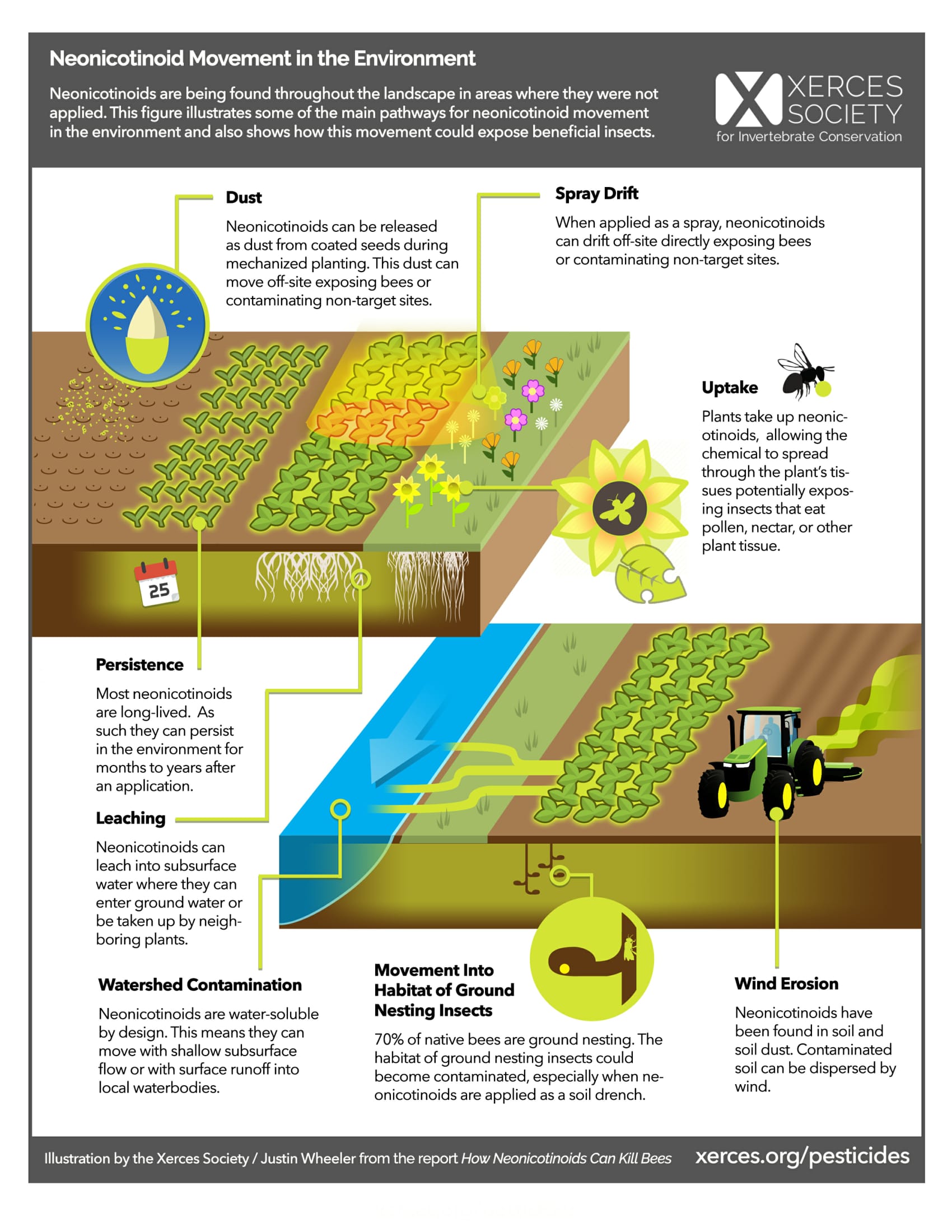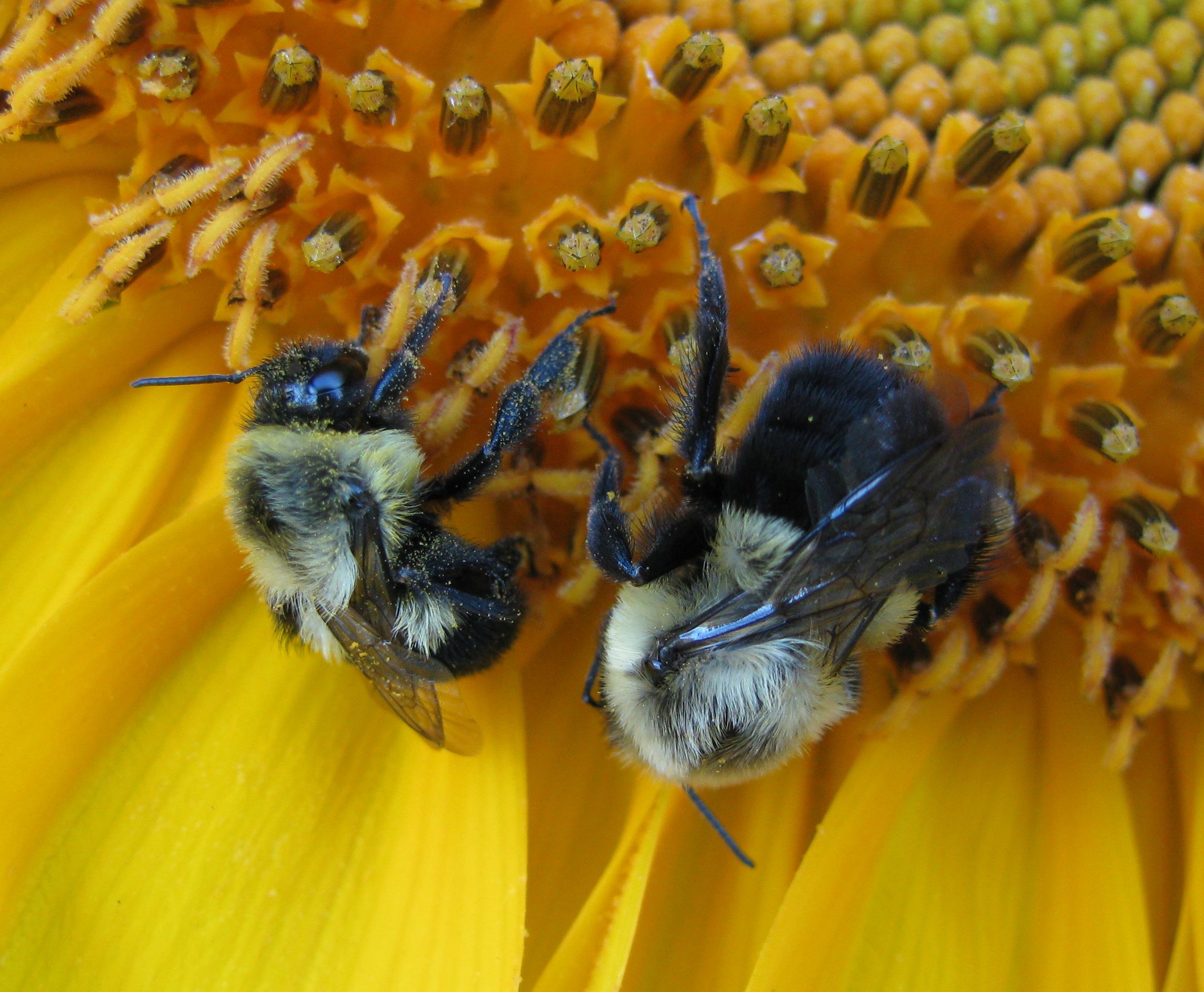Pesticide risk to bees is not simple or straightforward. There is indirect risk, such as when an herbicide application kills flowering plants thus limiting bees’ ability to gather pollen and nectar. There are also many direct risks that are not fully understood, such as the full effects of some fungicides on bees.
For direct harm to occur, there must be a pesticide exposure. In this blog we’ll dive into some of the possible ways that bees are exposed to pesticides, and how Bee Better growers are mitigating the risk of these exposures.
Pesticide exposure routes
When we think of bees being exposed to a pesticide, most people imagine a bee being sprayed while foraging. By taking a deeper look at the behavior and life cycle of native bees as well as how pesticides move and act in the environment, we quickly see that there are many ways a bee can be exposed.
Pesticide exposures can occur at the site of application as well as in areas that have not been treated but have become contaminated when the chemicals drift, leach or otherwise move off the intended site (Chauzat et al., 2006, Gill et al., 2012, Krupke et al., 2012, Botias et al., 2015, Hladik et al., 2016, Long and Krupke, 2016). There are many processes by which pesticides can move off-target during or after application.
Pesticide risk is complex; in simplest terms, risk is determined by the toxicity of the pesticide and the level of exposure. The level of exposure (e.g., how much of a pesticide the bee encounters), type of exposure (e.g., contact or oral), and the toxicity of the pesticide can determine how bees are affected. Bees exposed to multiple pesticides at the same time may experience synergistic or additive effects.
Direct contact exposure
This is the most obvious route of exposure, when bees encounter a direct hit from a pesticide application while flying or visiting flowers in an area where pesticide(s) are being or were recently applied. This is typically the most acute type of exposure, and may result in severe harm or death.
Residual contact exposure
Bees can be exposed to harmful pesticide residues hours to days after a pesticide has been applied – for example, when walking across treated leaves or flowers in a crop field, or when visiting flowers in nearby habitats that were contaminated with spray drift from a nearby application. Different pesticides and pesticide formulations have different residual toxicity concerns. Some pesticides break down quickly once dried and exposed to sunlight, others are more resistant to decomposition and persist longer in the environment. While data on residual toxicity isn’t always available, knowing if a pesticide is persistent and looking into the potential for products to stay lethal to bees hours to days after an application can help avoid harmful exposures.
Contaminated nectar and pollen
Bee foraging on flowers in treated crop fields and nearby natural areas subject to spray drift and leaching may ingest contaminated pollen and nectar, or carry this contaminated food back to the nest to feed to developing offspring. This exposure can occur immediately after an application, or long after treatment for highly persistent pesticides.
Systemic insecticides such as neonicotinoids can be transported through plants and expressed in pollen and nectar. Bees can be much more sensitive to oral pesticide exposure than topical/contact exposure. Both adults and developing larvae can receive chronic, long-term exposure to low levels of pesticides via contaminated nectar and pollen. This chronic dietary exposure to pesticides can lead to a suite of sublethal behavioral and reproductive effects.

Contaminated nesting areas or materials
Pesticide applications may contaminate the nesting materials used to construct bee nests, such as the mud used to construct mason bee nest cells or the leaves used to partition cells of leafcutter bee nests. More broadly, pesticide applications can contaminate the areas where bees nest in and around crop fields. Around 70% of native bees in the United States nest in the ground, including many at shallow depths where they may be at risk of contact exposure from soil-applied pesticides or treated seeds. These bees are present on farms – and therefore at risk of exposure – all year long.
What does Bee Better do to prevent or minimize exposure to pesticides?
Bee Better growers take many steps to minimize bee exposure to toxic pesticides in crop fields and surrounding natural areas and pollinator habitat.
The Bee Better pest management standards incorporate non-chemical pest management methods to help increase the resilience of crops and to manage pests through non-chemical means. All pesticide use also must be in response to verifiable need. These core components of Bee Better, which limit pesticide use, minimize the risk of bees being exposed to pesticides. Simply put, fewer pesticides used makes exposure less likely.
When either organic or conventional pesticides are part of a farm’s management plan, Bee Better also incorporates methods to help avoid harmful exposures. Bee Better prohibits application of pesticides rated as level I under the Bee Precaution system maintained by the University of California IPM Program as well as certain fungicides during crop bloom, and requires mowing of in-field flowering temporary habitat before any pesticide application.
Spatial and vegetative pesticide buffers around permanent pollinator habitat help to prevent contamination of these areas, providing better protected nesting areas and materials as well as pollen and nectar resources for wild and managed bees. Bee Better prohibits the use of all pesticides, except most herbicides, in these habitat areas.
Because systemic insecticides can be expressed in the pollen and nectar of wild and crop plants long after application, these pose a greater oral exposure risk for bees. Bee Better growers cannot apply the highly toxic and systemic nitroguanidine neonicotinoid insecticides, including the planting of treated seeds.
Finally, Bee Better growers that choose to apply pesticides are required to calibrate their application equipment to help ensure applications are not above legal limits and to minimize off-site pesticide drift that might contaminate wild flowering plants.
Regardless of these measures, it is important to note that there will almost always be exposure risk that Bee Better growers cannot control, even for growers that do not apply any pesticides. Bees may travel into nearby crop fields after pesticides have been applied, receiving residual contact exposure on treated foliage. Bees can also be exposed throughout their foraging radius to pesticides used by neighboring landowners or municipalities (Long & Krupke, 2016). While some small solitary bees may only travel 50 meters from their nest site to collect pollen and nectar, honey bees and some other large-bodied bees can travel miles for food and thus may be exposed directly to pesticides applied in several square miles surrounding their nest.
Bee Better growers work to create a safe haven for pollinators, providing high-quality pollinator habitat protected from heavy pesticide contamination.
For more information on pesticide risks to bees, see the following resources:
U.S. Environmental Protection Agency, Office of Chemical Safety and Pollution Prevention. Residual Time to 25% Mortality Data. Available: https://www.epa.gov/pollinator-protection/residual-time-25-bee-mortality-rt25-data
University of California IPM Bee Precaution Pesticide Rating. http://www2.ipm.ucanr.edu/beeprecaution/
Code, A., H. Sardinas, T. Heidel-Baker, J.K. Cruz, S.H. Black, E. Lee-Mader, M. Vaughan, & J. Hopwood. 2016. Guidance to Protect Habitat from Pesticide Contamination. The Xerces Society for Invertebrate Conservation. https://xerces.org/publications/fact-sheets/guidance-to-protect-habitat-from-pesticide-contamination
Hopwood, J., A. Code, M. Vaughan, & S.H. Black. 2016. Recommendations to Protect Pollinators from Neonicotinoids. The Xerces Society for Invertebrate Conservation. https://xerces.org/sites/default/files/2018-05/NeonicsBeeRecommendations_XercesSociety.pdf
Hoovin, L., R. Sagili, & E. Johansen. 2013. How to Reduce Bee Poisoning from Pesticides. Oregon State University, University of Idaho, & Washington State University. Extension Bulletin PNW-591. https://catalog.extension.oregonstate.edu/sites/catalog/files/project/pdf/pnw591.pdf
May, E., J.K. Wilson, & R. Isaacs. 2015. Minimizing Pesticide Risk to Bees in Fruit Crops. Michigan State University Extension, E-3245. http://msue.anr.msu.edu/uploads/resources/pdfs/Minimizing_Pesticide_Risk_to_Bees_in_Fruit_Crops_(E3245).pdf

